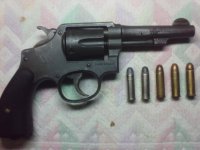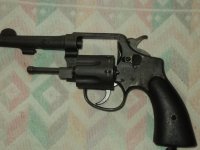Hello guys! I am a new member of the group and I want to ask assistance to identify this revolver, what year it was manufactured... and maybe to ask if this piece is authentic smith and wesson.. I am attaching some photos for you to evaluate, thanks!
-
Forum Update: We've upgraded the software to improve security, performance, and the overall experience.
👉 Read why we made the change | Support the Forum
You are using an out of date browser. It may not display this or other websites correctly.
You should upgrade or use an alternative browser.
You should upgrade or use an alternative browser.
Is this a pre-war revolver?
- Thread starter rsrojas
- Start date
Register to hide this ad
Welcome to the forum. That is actually a wartime revolver that was manufactured in the summer of 1942, to judge from its serial number. It is familiarly called a Victory Model. It is basically the same gun that S&W marketed before and after the war as the .38 Military and Police, but with some manufacturing economies (simpler stocks, rougher finish) to speed production and keep unit costs down during the war since the government bought most of them. Hundreds of thousands were made.
The Victory model revolvers are an interesting class of S&W revolvers whose many sub-varieties keep collectors busy in the attempt to gather up specimens of all of them. If you search in the forum archives, you can find hundreds of threads about individual specimens as well as some of the different types.
If your gun does not have a Government Property stamp on it, it was probably produced as a DSC gun, which stands for Defense Supplies Corporation. That was a federal agency that managed firearms purchases for non-military agencies that had a legitimate need for firearms in the course of the war but could not buy directly from the factories. Guard forces for essential industries and local law enforcement agencies would be examples.
If it is mechanically sound, you can shoot it with standard .38 Special ammo without worries.
The Victory model revolvers are an interesting class of S&W revolvers whose many sub-varieties keep collectors busy in the attempt to gather up specimens of all of them. If you search in the forum archives, you can find hundreds of threads about individual specimens as well as some of the different types.
If your gun does not have a Government Property stamp on it, it was probably produced as a DSC gun, which stands for Defense Supplies Corporation. That was a federal agency that managed firearms purchases for non-military agencies that had a legitimate need for firearms in the course of the war but could not buy directly from the factories. Guard forces for essential industries and local law enforcement agencies would be examples.
If it is mechanically sound, you can shoot it with standard .38 Special ammo without worries.
Last edited:
DWalt
Member
From the picture, I cannot make out the serial number on the butt very well. What is it, and does it have a "V" prefix? Is the same number stamped inside the right grip panel? Also, on the topstrap (above the cylinder), is it stamped "U. S. NAVY", "UNITED STATES PROPERTY", or "U.S. PROPERTY"? Is the caliber stamping on the barrel ".38 S&W SPECIAL CTG"? It is certain to be a pre-Victory or Victory Model from WWII, but without the foregoing information, it cannot be identified more completely.
gjamison
SWCA Member
I believe the serial number is V43616.
DWalt
Member
V43616 would date its shipment at about July 1942. Assuming the caliber stamping is .38 S&W Special, it was a Victory Model made for United States use. A huge number of identical revolvers were made in .38 S&W caliber (not the same as .38 S&W Special) for use by the British Commonwealth. If there is a U. S. NAVY or UNITED STATES PROPERTY topstrap stamping, it was made for military issue. The Navy took most of them, and they were the standard armament for naval aviation flight crews. With no topstrap stamping, it would most likely be what is called a "DSC" (Defense Supplies Corporation) revolver, and would have been used stateside by law enforcement and defense plant security guards. The dull finish is phosphate, not bluing. It was much easier and cheaper to apply than bluing. Do not even think about removing the finish and having it blued. Keep it exactly as-is.
Last edited:
DWalt
Member
You actually hit the jackpot. The Navy Victories are the most prized among the more common Victories. They were made only up to early 1943, specifically under Navy contracts (at least most of them), and are less common. You most definitely should not mess with it in any way. But if you plan to shoot it, that's OK.
Yes "U.S. NAVY" is stamped on the topstrap and ".38 S & W SPECIAL CTG" on the barrel. Thanks for the advice to retain its finish, I actually had thought of rebluing it. I haven't seen the inside of the grip to see if the same S/N are stamped on it... I'll do it later. Thanks guys!
DWalt
Member
.38 S&W is a shorter and fatter cartridge than the .38 S&W Special. The two are not interchangeable. .38 S&W is still loaded, but not widely distributed. Tough to find, and expensive when found. Just the opposite with the .38 Special.
Last edited:
Yes sir I'll try to shoot it soon! By the way, what is the difference between .38 cal cartridge and .38 special cartridge? It is correct to assume that all .38 cartridges manufactured today are the .38 special cartridges?
The British version of the Victory model was chambered for the .38 S&W cartridge which is shorter and slightly larger in diameter than the .38 special. It is still in production, but is not common and it is also a mite pricey.
There have been a number of .38 cartridges over the years-.38 Short Colt, .38 Long Colt, .38 Ballard, .38 rimfire, etc.
Thank you very much guys, you have been quite informative, I really appreciate it! I have another question about the Victory model.. Do you think this piece is already equipped with a the safety feature "hammer block"? I had read somewhere that the "S" marking on the plate signifies the safety feature.
DWalt
Member
Thank you very much guys, you have been quite informative, I really appreciate it! I have another question about the Victory model.. Do you think this piece is already equipped with a the safety feature "hammer block"? I had read somewhere that the "S" marking on the plate signifies the safety feature.
No. that did not occur until very early 1945. While a few earlier Victories were later retrofitted with the new and improved hammer block safety, yours is not likely to have been one of them. The safety is designated by the letter S ahead of the V, i.e., SN SVxxxxxx. Yours is as safe as it needs to be.
Just don't drop in on the hammer and you will be fine... and welcome to the forum...
and welcome to the forum...
Welcome to the forum. Cool gun. As to rebluing, my opinion is that the gun in it's current condition may not be perfect, but it's honest (meaning original.) If reblued, it will be neither.
But many do reblue old Smiths and they look nice...or nicer. Just my 2 cents. Best wishes.
But many do reblue old Smiths and they look nice...or nicer. Just my 2 cents. Best wishes.
gunnails
Member
Where are you located rsrojas? We here refer to these as reloads Vs refills, My opinion is that the lead is better suited for your gun then a FMJ. , as the lead is easier on the gun barrel and components then metal.
Either way I like your gun.
Either way I like your gun.
Springfan
SWCA Member, Absent Comrade
Excellent question, Gunnails. Rsrojas, Forum members are always interested in the history of a particular firearm, and in this case, we might wonder if a U.S. Navy Victory model travelled to Luzon Islands with a Navy pilot during the war. Do you know anything about the history of this revolver? It sounds like you plan to have the grips off, are there non-factory markings inside the grips?
(As an example, I am current caretaker of a 1942 Navy Victory, and inside the left grip is marked Nov 1945 NARS Bill Maze (?) Charlestown (?) RI. (In 1945 the abbreviation for Rhode Island would have been R.I.))
(As an example, I am current caretaker of a 1942 Navy Victory, and inside the left grip is marked Nov 1945 NARS Bill Maze (?) Charlestown (?) RI. (In 1945 the abbreviation for Rhode Island would have been R.I.))
Last edited:
Similar threads
- Replies
- 47
- Views
- 3K
- Replies
- 9
- Views
- 495
- Replies
- 38
- Views
- 2K



